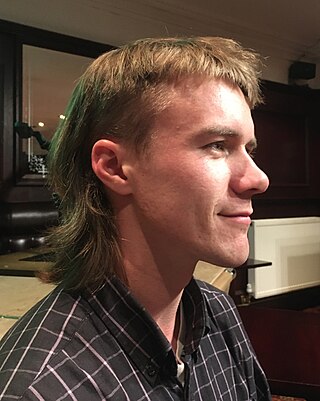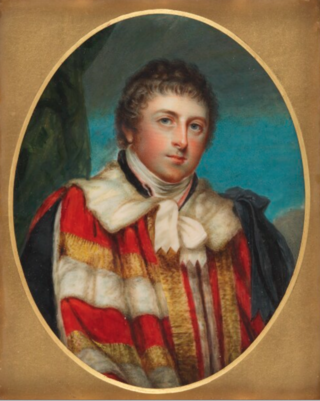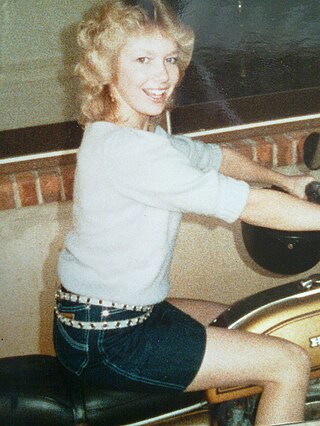
A buzz cut, or wiffle cut, is a variety of short hairstyles, especially where the length of hair is the same on all parts of the head. Rising to prominence initially with the advent of manual hair clippers, buzz cuts became increasingly popular in places where strict grooming conventions applied. In several nations, buzz cuts are often given to new recruits in the armed forces or newly incarcerated inmates. However, buzz cuts are also used for stylistic reasons.

The mullet is a hairstyle in which the hair is cut shorter at the front, top and sides, but is longer at the back.
Popular music of the United Kingdom in the 1980s built on the post-punk and new wave movements, incorporating different sources of inspiration from subgenres and what is now classed as world music in the shape of Jamaican and Indian music. It also explored the consequences of new technology and social change in the electronic music of synthpop. In the early years of the decade, while subgenres like heavy metal music continued to develop separately, there was a considerable crossover between rock and more commercial popular music, with a large number of more "serious" bands, like The Police and UB40, enjoying considerable single chart success.

The quiff is a hairstyle that combines the 1950s pompadour hairstyle, the 1950s flattop, and sometimes a mohawk. It was born as a post-war reaction to the short and strict haircuts for men. The hairstyle was a staple in the British Teddy Boy movement, but became popular again in Europe in the early 1980s and experienced a resurgence in popularity during the 1990s.

A bob cut, also known as a bob, is a short to medium length haircut, in which the hair is typically cut straight around the head at approximately jaw level, and no longer than shoulder-length, often with a fringe at the front. The standard bob cut exposes the back of the neck and keeps all of the hair well above the shoulders.

Hip-hop fashion refers to the various styles of dress that originated from Urban Black America and inner city youth in cities like New York City, Atlanta, and Los Angeles. Being a major part of hip hop culture, it further developed in other cities across the United States, with each contributing different elements to the overall style that is now recognized worldwide.

The high and tight is a military variant of the crew cut. It is a very short hairstyle, characterized by the back and sides of the head being shaved to the skin and the option for the top to be blended or faded into slightly longer hair. It is most commonly worn by men in the U.S. armed forces. It is also popular with law enforcement officers and other public safety personnel. Although "high and tight" is the primary term used in military and law enforcement, the same haircut is sometimes referred to by civilians as a "walker".

Kid 'n Play is an American hip-hop duo from New York City who were most popular in the late 1980s and early 1990s. The duo is composed of Christopher Reid ("Kid") and Christopher Martin ("Play") working alongside their DJ, Mark "DJ Wiz" Eastmond. Besides their musical careers, they also branched out into acting.

A crew cut is a type of haircut in which the upright hair on the top of the head is cut relatively short, graduated in length from the longest hair that forms a short pomp (pompadour) at the front hairline to the shortest at the back of the crown so that in side profile, the outline of the top hair approaches the horizontal. Relative to the front view, and to varying degrees, the outline of the top hair can be arched or flattened at the short pomp front and rounded or flattened over the rest of the top to complement the front hairline, head shape, face shape and facial features. The hair on the sides and back of the head is usually tapered short, semi-short, or medium.

Christopher Reid, formerly known as Kid, is an American rapper, actor and comedian. During the peak of his career with the rap duo Kid 'n Play, with Christopher Martin, Reid was notable for both his seven-inch, vertical hi-top fade and freckles.

A flattop is a classic hairstyle characterized by short hair on the sides and back of the head, with the top hair cut short and styled to stand upright in a flat, level plane.

Fashion in the 1990s was defined by a return to minimalist fashion, in contrast to the more elaborate and flashy trends of the 1980s. One notable shift was the mainstream adoption of tattoos, body piercings aside from ear piercing and, to a much lesser extent, other forms of body modification such as branding.

The fashion of the 2000's is often described as a global mash up, where trends saw the fusion of vintage styles, global and ethnic clothing, as well as the fashions of numerous music-based subcultures. Hip-hop fashion generally was the most popular among young people of all sexes, followed by the retro inspired indie look later in the decade.

An eponymous hairstyle is a particular hairstyle that has become fashionable during a certain period of time through its association with a prominent individual.
The Rachel haircut, commonly known as simply "The Rachel", is an eponymous hairstyle popularized by American actress Jennifer Aniston. Named after Rachel Green, the character she played on the American sitcom Friends (1994–2004), Aniston debuted the haircut during the show's first season, and continued to wear it throughout its second season while the series was nearing peak popularity. Designed by Aniston's hairstylist Chris McMillan to repair her damaged hair and grow out her bangs, "The Rachel" is a voluminous shoulder-length haircut, with several distinct layers that frame and turn outwards from its wearer's face. It has been described as a variation on both the shag and bob haircuts.

The wings haircut, also known the Mod haircut, Mop top, flippies, flow, Justin Bieber haircut, or skater hair is a popular hairstyle used in the skateboarding, surfer, mod, and preppy community. Typically long, the style can range from long and drooping below the eyes, to a shorter length. The haircut is typically wavy and, if straight, the length comes to halfway down the ears. Instead of lying on the wearer's ears, the hair flips up and comes straight out like an airplane wing, hence the name. The hairstyle was popular among men in the 1960s, 1970s, mid-late 2000s, early 2010s and 2020s.

A shape-up, also called a line-up or an edge-up, is a hairstyle that involves cutting along the natural hairline to straighten it. Edge-ups are typically found among men and short-haired women. The haircut grew in popularity during the 1980s, typically among those who have Afro-textured hair, and became the precursor to other stylish haircuts, such as the high-top fade, low fade, and designs such as crescent moon parts, side parts, and waves in hair.

The temple fade, also known as a Brooklyn fade, taper fade, and blowout, is a haircut that first gained popularity in the late 90s and early 2000s in African American, Italian American, and Hispanic American barbershops as a variation of the bald fade, originating primarily in the Northeastern United States, particularly in New York City and especially Brooklyn.

The 2010s were defined by hipster fashion, athleisure, a revival of austerity-era period pieces and alternative fashions, swag-inspired outfits, 1980s-style neon streetwear, and unisex 1990s-style elements influenced by grunge and skater fashions. The later years of the decade witnessed the growing importance in the western world of social media influencers paid to promote fast fashion brands on Pinterest and Instagram.

Hairstyles in the 1980s included the mullet, tall mohawk hairstyles, jheri curls, flattops, and hi-top fades, which became popular styles. Amongst women, large hair-dos, puffed-up styles, permanent waves, and softer cuts typified the decade. Big hair that was "often permed to achieve the desired volume" is especially associated with women of the mid 1980s as well as male rockstars of that era, especially of the glam metal genre. Television shows such as Dynasty helped popularize the high volume bouffant and glamorous image associated with it.





















